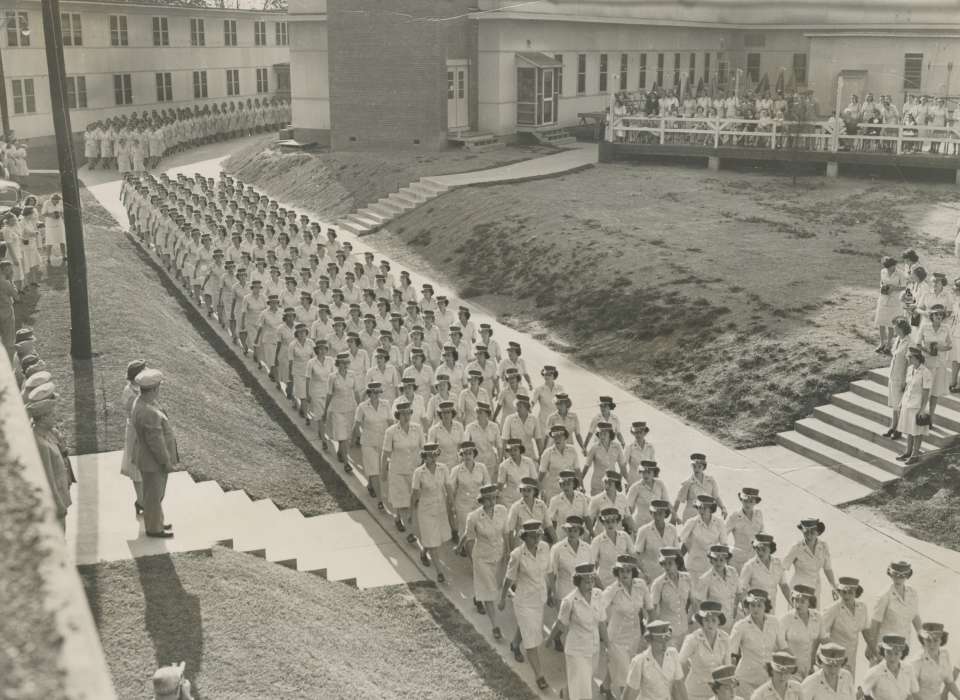NEW ORLEANS (Nov. 11, 2023) — On Veterans Day 2023, The National WWII Museum debuted Our War Too: Women in Service, a groundbreaking special exhibit honoring the nearly 350,000 American women who answered the call to serve their country during World War II. Presented by the Gayle and Tom Benson Charitable Foundation, the exhibit explores the efforts, struggles and accomplishments of these servicewomen, the impacts of which extend into the present day. Our War Too will be on display at the New Orleans museum in the Senator John Alario, Jr. Special Exhibition Hall through July 21, 2024, before traveling to other venues across the country.
“It is a great privilege to help The National WWII Museum bring this important exhibit to life and honor the brave, trailblazing women of World War II,” said Gayle Benson, owner and chief executive officer of the New Orleans Saints and Pelicans. “Being able to tell their barrier-breaking stories will empower a new generation of girls and women in New Orleans and nationwide, hopefully inspiring them to embody the winning spirit of these heroes.”
Our War Too: Women in Service was unveiled as part of the Museum’s Veterans Day Commemoration presented by Bank of America on Saturday, Nov. 11. Featured speakers included Museum Trustee Suzanne Mestayer; Captain Lena Kaman, USN, Commanding Officer of Naval Air Station Joint Reserve Base New Orleans; Darvelle Hutchins, Vice President of Equity and Social Impact for the Saints and Pelicans; and Kim Guise, Museum Senior Curator and Director for Curatorial Affairs. Women who have served in the US Armed Forces were recognized at the commemoration ceremony and led a second-line parade to the official ribbon-cutting for the exhibit. Among those in attendance were WWII veterans Romay Johnson Davis, a Women’s Army Corps driver in the segregated African American 688th Central Postal Directory Battalion, and Virginia Leeman Wilterdink, a US Army nurse who served with the 314th General Hospital Unit.
The popular and historical narrative of American women during World War II often focuses on those who worked on the Home Front, while stories of women who volunteered for vital roles in the uniformed services are largely underrecognized. Our War Too: Women in Service salutes the hundreds of thousands of women who served in the women’s component branches of the US Army, Coast Guard, Navy and Marine Corps, and with the civilian Women Airforce Service Pilots (WASP), as well as the additional 73,000 women who served in the Army and the Navy Nurse Corps.
“The servicewomen of World War II remain role models for girls and young women, especially those within or considering uniformed service,” said Guise, curator of Our War Too. “Women are the fastest-growing veteran group, numbering 2 million nationwide. And as the fight for equality continues, Our War Too: Women in Service recognizes the path forged during World War II that is still being traveled by women in the American military today.”
Through new, innovative technology introduced in the exhibit, visitors have the opportunity to hear from three WWII servicewomen in their own words through stations featuring We Were There interactive biographies: Davis, Wilterdink and SPAR Florence Smith, a baker for the US Coast Guard Women's Reserve. Using cutting-edge technology and interactive video displays, We Were There allows guests to hold conversations with these women, an effect made possible through artificial intelligence. Produced by StoryFile, a leader in immersive technology and video capture, each interview includes as many as 1,000 questions about the subject’s life and wartime experience, creating a robust repository of responses for the software to match to verbal questions from visitors.
Our War Too also features unique and colorful artifacts from the Museum’s collection, many on display for the first time, that highlight the personal stories and motivations of individual servicewomen. As recruitment efforts marketed service as both a patriotic duty and a wise career move, women utilized their talents and expertise to fill crucial gaps across different levels of the Armed Forces. Whether working in traditionally female roles or taking on unexpected tasks, servicewomen learned new skills and gained experience they would never have earned outside of wartime.
But these opportunities came with limitations. Women were expected to serve temporarily, on an emergency basis, and did not have a full sense of belonging within the military despite answering the call of duty to their country. Our War Too delves into the struggles servicewomen faced both at home and overseas.
“These women often waged personal battles with their families, combated negative stereotypes and grappled with discrimination, while giving their all for Allied victory. We’re proud to be able to share their stories of bravery and sacrifice, as a salute to their invaluable service and its legacy,” Guise said.
In addition to artifacts, Our War Too’s digital elements include an interactive scrapbook that allows visitors to explore some of the treasures within the Museum’s archive of wartime albums and memory books curated by women to remember their time in service. Film pieces examine women’s service in the war and their legacy today, featuring interviews with women who served in the footsteps of WWII volunteers.
The National WWII Museum tells the story of the American experience in the war that changed the world—why it was fought, how it was won, and what it means today—so that all generations will understand the price of freedom and be inspired by what they learn. Dedicated in 2000 as The National D-Day Museum and now designated by Congress as America’s National WWII Museum, the institution celebrates the American spirit, teamwork, optimism, courage and sacrifices of the men and women who fought on the battlefront and served on the Home Front. For more information on Tripadvisor’s #1 New Orleans attraction, call 877-813-3329 or 504-528-1944 or visit nationalww2museum.org.
